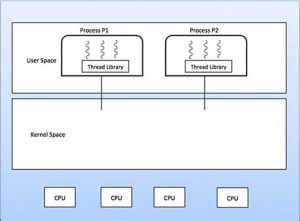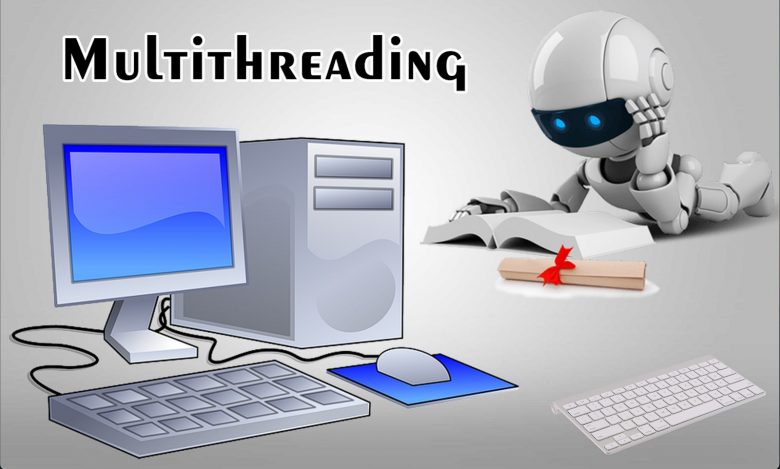Multithreading in operating system
In a single process, numerous execution threads can execute simultaneously thanks to the multithreading approach. Multithreading is a crucial idea in operating systems that helps to improve the system’s overall effectiveness and performance.
The notion of multithreading in operating systems, its benefits, and its implementation will all be covered in this blog.

What is Multithreading?
The process of establishing several threads of execution within a single process is known as multithreading. Using the same resources, such as memory and CPU time, each thread operates independently and concurrently. The threads talk to one another by passing messages or by sharing memory.
Advantages of multithreading:
- Improved Responsiveness: Multithreading allows the operating system to handle multiple tasks simultaneously, which improves the responsiveness of the system. This is particularly important in real-time systems where quick response time is critical.
- Resource Sharing: By allowing threads to share resources like memory and I/O devices, multithreading lowers resource consumption and boosts productivity.
- Simplified Design: By dividing complex systems into smaller, more manageable threads, multithreading makes complex system design simpler. This frees up developers from having to worry about the system’s overall complexity so they may concentrate on certain system components.
- Higher Throughput: By executing many threads simultaneously, multithreading enables the system to make use of idle CPU time. The system’s overall throughput is increased as a result of being able to accomplish more work in the same period of time.
Implementation of Multithreading:
The operating system implements multithreading using either the kernel-level threads model or the user-level threads model.
- User-level threads: User-level threads are controlled by the program and do not need the operating system’s assistance. The program controls each thread and chooses when to switch between them. Although this method is simple and effective, it has some drawbacks, including bad synchronization and no support for multicore processors.
- Kernel-level threads: The operating system is in charge of managing kernel-level threads and offers assistance with thread generation, scheduling, and synchronization. Because each thread has its own kernel-level data structure, the operating system can more effectively handle it. Better synchronization and support for multicore CPUs are provided by this strategy, but is less efficient than user-level threads.
Some Real Life Applications Of Multithreading
Web browsers – A web browser allows you to browse while simultaneously downloading any number of files and web pages (many tabs). If a particular online page cannot be downloaded, that is not going to hinder the web browser from downloading other web pages.
Text editors – While you are typing in an editor, numerous threads are working simultaneously to spell-check, format, and save the text. The same holds true for word processors.
IDE: IDEs run numerous threads concurrently, such as Android Studio. You can run several apps simultaneously. Additionally, it offers recommendations for how to finish a command that is in a different thread.
Web servers – A threaded web server starts a new thread for each request. Every time a new request is received, one of the threads in the thread pool is chosen to handle it.
Computer games – You can implement different things, such as automobiles, people, and birds, as distinct threads. Multithreading is exemplified by simultaneously playing the game and the background music.
Conclusion:
In a nutshell, an essential idea in operating systems is multithreading, which enables numerous threads of execution to operate simultaneously within a single process. It offers many benefits, including enhanced responsiveness, increased throughput, and a more straightforward construction. Depending on the particular needs of the system, multithreading can be done using either user-level threads or kernel-level threads and plays a vital role in our daily life computer applications.
Improved Responsiveness: Multithreading allows the operating system to handle multiple tasks simultaneously, which improves the responsiveness of the system. This is particularly important in real-time systems where quick response time is critical
Improved Responsiveness: Multithreading allows the operating system to handle multiple tasks simultaneously, which improves the responsiveness of the system. This is particularly important in real-time systems where quick response time is critical
Improved Responsiveness: Multithreading allows the operating system to handle multiple tasks simultaneously, which improves the responsiveness of the system. This is particularly important in real-time systems where quick response time is critical
Improved Responsiveness: Multithreading allows the operating system to handle multiple tasks simultaneously, which improves the responsiveness of the system. This is particularly important in real-time systems where quick response time is critical
Improved Responsiveness: Multithreading allows the operating system to handle multiple tasks simultaneously, which improves the responsiveness of the system. This is particularly important in real-time systems where quick response time is critical


